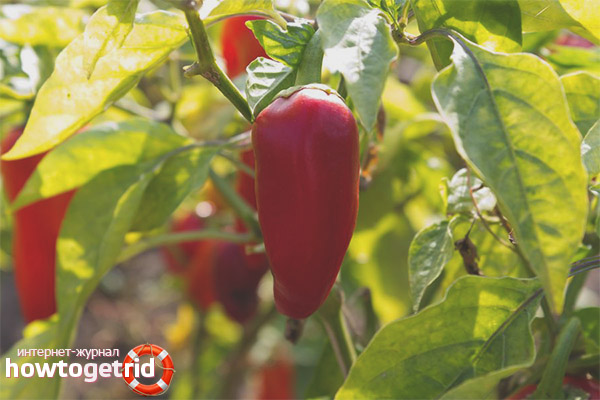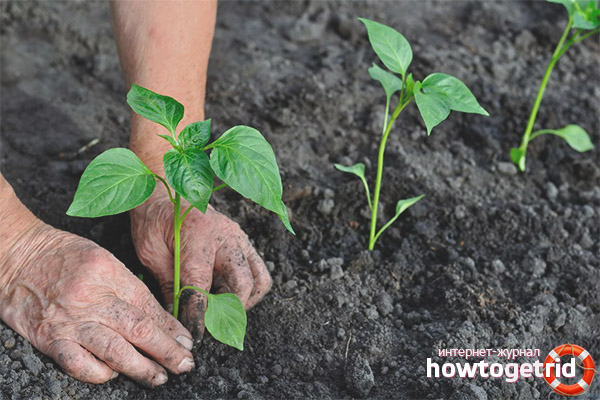The content of the article
Bell peppers belong to the nightshade family. This culture is thermophilic, does not tolerate drafts, waterlogging. The leaves have a saturated green color due to the high concentration of chlorophyll. During flowering and fruiting, the plant looks very attractive.
Description
The variety is characterized by rapid ripening, plentiful harvest and tasty fruits. The variety is universal, suitable for fresh consumption, and for canning.
Pepper seeds germinate at a temperature of 14 degrees. The optimum temperature for growing crops is 22-24 degrees. If the temperature drops to 5 degrees, seedlings can die, even if it was hardened. Variety Swallow refers to photophilous, thermophilic and moisture-loving varieties of bell pepper.
Growing seedlings
The shelf life of pepper seeds is 2-3 years. Buy planting material only from trusted manufacturers, in seed stores.
Before planting seeds, they should be treated with a potassium permanganate solution or fungicide. You can immerse the seeds in a biostimulant solution for fast germination.
Some novice gardeners try to sow seeds as early as possible in February, and then at the end of January, hoping to get an early harvest. But this is an erroneous opinion. It is best to plant seeds of bell pepper in mid-March.
Take full responsibility for preparing the soil for growing seedlings. You can’t just go outside and dig up the land. The soil should be structured, loose, fertile.
Pepper seeds are sorted out, removing all deformed and small specimens, then disinfected in a strong solution of potassium permanganate for 15 minutes.
It is necessary to sow not densely, otherwise the sprouts will be extended. Sow the seeds in the grooves, cover with a film or glass. Planted seeds must be kept warm at a temperature of 20-22 degrees.
As soon as a whitish loop appears from the ground, you can place the pots with future peppers on a bright window. If the seedlings grow on one side, they must be rotated every 2-3 days. Failures with the cultivation of seedlings of bell pepper are mainly associated with the temperature regime and the presence of drafts. It is not recommended to make dense landings.
Seedlings are grown in boxes or cups. The seed placement depth is 1.5 cm. You should not bury the seeds too deep into the ground, they can simply not germinate.
Cover the emerged seedlings with polyethylene or glass, pour from the spray gun with warm water. When steady warm comes, the weather will harden the seedlings.
It is very important to illuminate the seedlings of pepper with special lamps in the morning and evening. In early March, the daylight is still not long enough, the plants lack sunlight, especially in cloudy, inclement weather. If you grow pepper without illumination, then the seedlings are stretched, become painful and frail. Such seedlings do not take root well, get sick and subsequently yield a meager harvest.
After the sprouts are well rooted, you can begin to take out a box with seedlings on the street.
At elevated temperatures, in combination with a small amount of light, seedlings will grow frail, weak, stretch upward and not grow leaves.
If you plan to grow pepper in the open ground, then seedlings from three weeks old need to be hardened, taken out on the balcony for several hours. If you plan to grow pepper in a greenhouse, then you do not need to temper the seedlings.
The air in the room where the bell pepper seedlings are grown should not be dry. Pepper does not tolerate drafts. When watering, try so that the drops do not fall on the young foliage.
Do not allow water to stagnate in the container where the seedlings are grown. Due to excessive moisture, the root system rots. When the first shoots appear, the film is removed and the container is rearranged on the windowsill.
At the age of 3-4 weeks, peppers are dived into separate pots. If you leave the plants in a box, then they will begin to compete for light and nutrients. Seedlings need fertilizing with nitrogen fertilizers.
Seedlings should be 25 cm long, buds are allowed. If you find an ovary during transplantation, it is better to remove it. Before planting, seedlings are carefully watered. Try to get a plant with a lump of earth, the fact is that the roots of the pepper can easily be injured, and they take root much worse compared to the root system, for example, tomatoes. Growing seedlings in cassettes allows you to get a large amount of planting material in small areas of protected ground.
The main thing is to have time to sow the seeds of bell pepper before April, otherwise it will bloom too late, and the fruits will not have time to ripen. For growing seedlings, ordinary plastic cups or peat tablets are suitable. One of the conditions for obtaining healthy seedlings is timely watering. The soil is suitable sandy loam or chernozem.
Healthy potted seedlings are a guarantee of a high yield of pepper Swallow. You can grow seedlings in peat tablets, you can buy them in any specialized store.
Planting seedlings in the ground
At the age of 35 days, seedlings of bell pepper are transplanted to a permanent place of cultivation. Overgrown, high seedlings restore roots for a long time, often lagging behind in growth.
Do not rush to plant seedlings in open ground as early as possible, it will be best if you wait for the onset of constant heat. Ready seedlings should have 10-12 leaves and several flowers. After planting the seedlings, the wells are watered and mulched.
Add humus, compost, a little ash to the planting hole, pour plenty of warm water. Water the planted bushes again and mulch the soil near them with straw or sawdust. Mulch prevents the evaporation of moisture from the surface layer of the soil.
In the first days after planting, you can use a film to make seedlings easier to adapt.
Three weeks later, loosen the soil and feed with saltpeter (2 matchboxes per bucket of water).
In rainy years, due to fungal diseases, up to 50% of the bell pepper crop can be lost. To prevent the appearance of apical decay, it is recommended to add potassium nitrate to the soil. During the formation of fruits, peppers are treated with biostimulants, growth regulators.
You can return pepper to its previous place of cultivation no earlier than 3 years later. In autumn, a large amount of organic fertilizers is applied to the soil.
Care
Although pepper Swallow variety is unpretentious, but to get an excellent harvest, you need to know a number of its features. Pepper is a thermophilic plant, therefore it cannot be watered with cold water.
During flowering, the variety reacts positively to phosphate fertilizers. At an air temperature of more than 35 degrees and low humidity, the pepper fades, the pollen becomes sterile, the ovaries are showered.
Plant the bushes staggered.A chessboard landing pattern is two beds, where the holes are staggered relative to each other.
Three weeks after transplanting, seedlings begin to remove stepsons. Properly formed bush, the key to a good harvest. Leaves should also be removed located at the surface of the soil.
Harvest fruits in the stage of technical ripeness. Pepper bears fruit in waves, in order to stimulate the appearance of new flower buds, it is necessary to pick ripening fruits in a timely manner.
Variety Swallow universal purpose, the fruits are suitable for fresh consumption and for canning.
Video: pepper Swallow











Submit